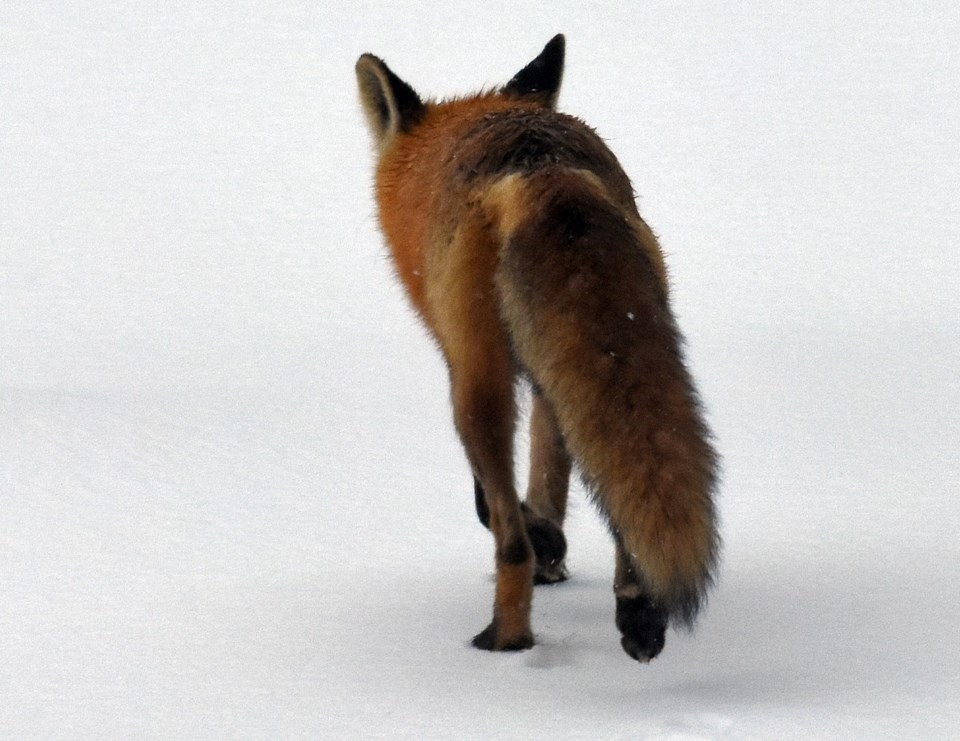As I haul garbage bags and blue bins out to the end of our lane, the neatly laid pattern of fox tracks in the snow caught my eye.
Each footprint was clearly defined, indicating that the critter had passed by quite recently. I glance around the yard, hopeful that I might catch sight of this elusive animal, but I'm probably about two hours too late.
According to the recycling rules, I actually am two hours late: "Please have your bags at the curb by 7 a.m.". Yeah, right, like that's going to happen. However, the urging to work in the dark does prompt me to get outside a tad earlier than my normal routine.
And you know what, the world does seem a little more vibrant, a little more new and less tarnished than at the end of the day.
No doubt the fox knows this, as the breaking of the overnight fast means if you want eat, you have to hunt. And the best hunting opportunities present themselves when your prey are also hungry and taking risks at exposing themselves as they seek weed seeds and dried berries.
When I was first introduced to this farm in the late 1970s, fox tracks were about the only tracks you did see. If the blanket of snow was imagined as a white quilt, the tracks stitched a wandering pattern from edge to edge, revealing the efficiency of a pair of foxes on the prowl.
As with all things in nature, the balance of power began to swing. Not that the meadow voles rose up and opposed the foxes, more like the foxes became the hunted.
As the once uncommon coyote started mating with farm dogs and a larger sized offspring was produced, these coy-dog brutes did their best to eliminate foxes from their newly claimed hunting grounds.
Not only were adults chased and caught, but in the springtime, fox dens were dug out and the young kits were eliminated. A few foxes survived, but they were few and far between.
As so, for the last few decades, coyotes became the dominant predator in our neighbourhood, their tracks becoming the commonplace sight, although much more wandering in pattern than the neat and dainty fox tracks.
At the time, I recall a few conversations where the disappearance of foxes was regarded by some as a good thing: "Rabies-laden beasts, good riddance." Unfortunately, there was only a part measure of truth to that sentiment.
Throughout the 1960s, southern Ontario was indeed under siege by sick foxes.
The rabies virus had somehow come south from the sled dogs of the high north, and a few factors contributed to the red foxes becoming Public Enemy No. 1.
One was that their population was high, the second was that they were mammals and therefore susceptible to contracting rabies if exposed, and the third factor was that male foxes roamed widely.
January is the mating season for foxes, and the vixen will hold a home territory, already with a den site established. The todds roam far and wide, seeking multiple females with which to mate.
This arrangement had worked for centuries upon centuries, but in 1960, the rules of the game changed. A wandering male fox that had been exposed to rabies (probably from fighting with another male) would brazenly bite horses, cattle, sheep, skunks, dogs, cats and the occasional human.
As soon as human health is threatened, all heck breaks loose to counter the attack. The humans printed several leaflets that went home with every school child, warning of the dangers of an encounter with a rabid animal.
We were to look for the signs: the animal was seen in daylight, it was staggering, it was foaming at the mouth, it was unafraid. So you be afraid, be very afraid!
The messaging worked so well that even today if a normally 'night time' animal is seen in the daylight, the children of that era (now learned adults) herd their own children inside, pull the blinds and fervent prayers are intoned. Well, maybe not exactly like that, but you know what I mean.
So why didn't the coyotes also get rabies during that time? They did, but they hid it well.
Rabies manifests as being "furious" or "dumb". The former means the affected animal can and will attack anything in its way, while the dumb form causes the animal to hide and die in seclusion. Foxes became furious, while coyotes tended to just disappear.
Starting in the 1970s and continuing to this day, the provincial government began dropping baited vaccine from aircraft, hoping that healthy animals would eat it and become immune to the actual rabies virus.
And the plan worked, and fox populations rebounded quickly. But the coyotes and coy-dogs were also on the rise and, as mentioned, the big boys eventually won.
However, nothing in Nature is static, at least not for long. In 2012 and 2013, mange swept through our region and both foxes and coyotes were infected. This time, the foxes escaped with less impact to their population than the coyotes.
And so my laneway has fresh fox tracks, and our fields have but one coyote trail. The balance of Nature is again swinging.
On the second morning of my early rising (because I had read the pick-up calendar wrong and had to put out the garbage bags and recycle bins, again), a new set of fox tracks pitter-pattered up the lane.
Seems that we're living within their new hunting grounds.



